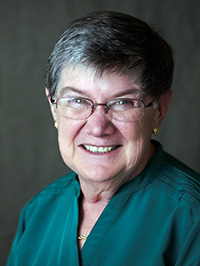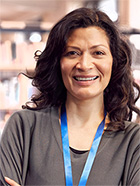How can educators identify and address potential barriers when designing instruction?
Page 4: Goals
 Just as a destination on a map lets travelers know where they will arrive at the end of their journey, a goal lets students know what expectation they should meet by the end of the lesson or unit. Moreover, it describes what students will understand, know, or be able to do as a result of the learning experience. A common phrase among educators who use UDL is “clear goals, multiple means.” In other words, educators must start with goals that are easily understood but that do not dictate the means, or the ways in which learning will take place.
Just as a destination on a map lets travelers know where they will arrive at the end of their journey, a goal lets students know what expectation they should meet by the end of the lesson or unit. Moreover, it describes what students will understand, know, or be able to do as a result of the learning experience. A common phrase among educators who use UDL is “clear goals, multiple means.” In other words, educators must start with goals that are easily understood but that do not dictate the means, or the ways in which learning will take place.
Clear Goals
Learning goals are powerful starting points when designing instruction. Educators should ensure that goals, whether developed by educators themselves or provided in a published curriculum, are written using clear, age-appropriate language. Depending on the lesson, goals may be content-based (e.g., understanding the Bill of Rights, figures of speech, or the Pythagorean Theorem) or skill-based (e.g., writing a persuasive paper, measuring length, conducting an experiment). In either case, the goal expresses what students should master by the end of the learning experience.
Goals should always be clearly communicated to students. To develop expert learners, educators need to inform students about what it is they are working to accomplish. Stating the learning goal at the beginning of a lesson helps students become goal-directed. Referencing goals throughout instruction assists learners with monitoring their own progress. Additionally, inviting students to co-construct goals or even to write personalized goals for themselves is a great way to build learner agency.
Multiple Means
In addition to being clear, goals must be separate from the means of learning. In other words, the goal must not prescribe only one way for all learners to achieve it. Rather, the goal should be flexible, offering students multiple pathways or routes to achieve it. Therefore, when developing goals, educators should anticipate barriers in the design that might interfere with students’ ability to accomplish the goal. With these in mind, educators should consider different ways for students to reach the goal—drawing on different interests, using different materials, and engaging in different tasks. Multiple means empower students to make choices based on their own strengths and needs. Even so, all students are ultimately working toward the same end goal.
Designing for multiple means of engagement, representation, and action and expression can look different depending on the type of learning goal:
- Content-based goals: When the goal is to master or understand content, educators can design multiple ways for students to demonstrate their learning of that content. For instance, if the goal is for students to understand the origins of jazz music, students can express their understanding in writing, through an illustration, or by composing a poem or song.
- Skill-based goals: When the goal is to master a skill, however, it may not be possible to offer multiple ways for students to demonstrate that skill. Some skill-based goals can only be demonstrated in one way. For example, if the goal is for students to play a musical scale on the trumpet, there is only one way to demonstrate mastery of the skill. However, educators can offer multiple options throughout the learning process to help students achieve the goal (e.g., notating sheet music, watching video tutorials). The goal remains “playing a musical scale,” but the process for reaching the goal is flexible.
Grace Meo provides more information about separating the goal from the means of learning for both content-based and skill-based goals.

Grace Meo, MEd
CAST Co-founder; Former CAST Director of
Professional Development & Outreach Services
Transcript: Grace Meo, MEd
So in thinking about the goal, we focus on identifying a goal that does not embed the means, the “how” to achieve the goal. Since once you embed the “how” into the goal, you’re actually restricting the goal to a certain population of students. And you want to really remove barriers from the achievement of the goal. So you want to design the goal so it is encompassing of all students. So, for example, if one were to set a goal of writing an essay on the causes and effect of the Civil War, what would happen by including the word “write” you’re going to eliminate those students for whom writing is a difficult task. If, in fact, though, the goal is a skill goal in which you really do want the students to write a particular thing, then you have to provide scaffolds for the students that have a difficulty in achieving that goal. So it might be that the process of writing, using a pencil and paper, is the difficulty, so you might provide an alternative such as a computer. Or if it’s difficult for a student to understand how to get started, you might provide a prompt with a sentence starter or structure for the student so they can, in fact, achieve the goal that you want to set out to achieve.
Putting It All Together
For Your Information
Sometimes educators mistake the assignment instructions for the learning goal. For example, “Read Chapter 3” is an instruction, not a goal. Goals express what students will learn rather than what they will do.
When educators design learning experiences, their first stop is the goal: What should students understand, know, or be able to do? If the goal is unclear or does not allow for multiple means, the educator should rewrite the goal. Consider the three versions of a life science goal below and how each one does or does not illustrate the notions of “clear goals, multiple means.”
| Goal | Clear Goal | Multiple Means |
|
Students will read the textbook chapter, watch a video, and make a multimedia presentation about ecosystems. |
X This goal includes directions for tasks with no clear statement of what students should understand about the content by the end of the lesson. |
X There is only one way for all students to reach the goal (i.e., making a multimedia presentation). |
|
Students will be able to describe the relationships among different parts of an ecosystem by making a multimedia presentation. |
This goal clearly states what students should be able to do by the end of the lesson (i.e., describe the relationships in an ecosystem). |
X There is only one way for all students to reach the goal (i.e., making a multimedia presentation). |
|
Students will be able to describe the relationships among different parts of an ecosystem. |
This goal clearly states what students should be able to do by the end of the lesson (i.e., describe the relationships in an ecosystem). |
Students could reach the goal of describing relationships in many ways (e.g., making a presentation, drawing a diagram, writing an essay, recording a video). |
Activity
Read each goal in the table below and determine if it is a clear goal and if it allows for multiple means. Check your answers and review the feedback for each goal.
| Goal | Clear Goal? | Multiple Means? |
|
Students will be able to create a self-portrait. |
Yes
No
|
Yes
No
|
|
Students will read Anne Frank: The Diary of a Young Girl and write a 5-paragraph essay about the book. |
Yes
No
|
Yes
No
|
|
Students will demonstrate their understanding of supply and demand by passing a multiple-choice quiz. |
Yes
No
|
Yes
No
|
|
Students will be able to measure the area of rectangles. |
Yes
No
|
Yes
No
|
Keep in Mind
As educators draft learning goals using a UDL lens, they should ask themselves the following questions:
- Have I crafted my goals clearly and in everyday language that learners can understand?
- How will I clearly communicate to learners what the goal is and what the goal means?
- In what ways can learners personally relate to and engage with this goal?
- Does the goal allow for flexibility in how learners can work toward the goal?
These questions have been adapted from the following handout.
Activity
Our three educators are now crafting UDL-aligned goals to drive their instruction. They remember that UDL-aligned goals should be clear and should allow for multiple means of engagement, representation, and action and expression. For each educator below, select the version of the learning goal that reflects the mantra, “clear goals, multiple means.”

Mr. Hughes
Elementary mathematics lesson
This goal clearly states what students should be able to do by the end of the lesson (i.e., represent data on a bar graph and answer questions). Students could reach the goal in many ways (e.g., using physical or digital graphs; answering questions orally, in writing, or using technology).

Ms. Tong
Middle school language arts unit
This goal clearly states what students should be able to do by the end of the unit (i.e., identify a theme and supporting details). Students could reach the goal in many ways (e.g., writing an essay, giving a presentation, recording a podcast, making a poster).

Mrs. Rios
High school biology lesson
This goal clearly states what students should be able to do by the end of the lesson (i.e., model and explain mitosis). Students could reach the goal in many ways (e.g., using three-dimensional, drawn, or digital models; designing an infographic; writing a skit; creating a video).
